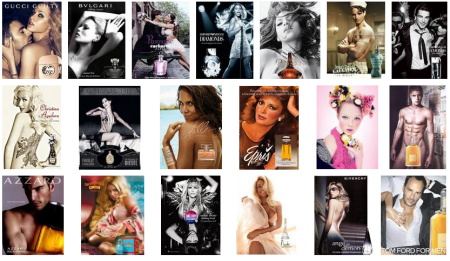
Identify, illustrate, and critically discuss the basic formats for fragrance ads in print.

Guidance
For general guidance about what is expected in your essays for this module, see the general criteria.
|
What Key Features Do I Look For?
|
Please remember to avoid footnotes and to include an alphabetical list of 'References' which have been cited in the text (not a Bibliography of anything you have read for the essay). This list should include author's names, date, book titles (in italics), place of publication and publisher. Within the text always cite author's surname, date and page number. Double-space your text and number your pages. For more detailed notes on writing essays in this department, click here.
Advice for this particular assignment: The primary focus here should be on identifying and illustrating what seem to be the most common formats for fragrance ads in terms of basic form--in particular, composition (the use of space, key elements and their placement in relation to each other). Illustrate these basic formats with the most typical examples that you can find of each type. The key elements are likely to include people (male/female), product and setting. Consider the framing of the person/people shown (headshot, midshot or full body; low-angle, high angle or level). Where there is more than one person note which ways they are facing and looking (e.g. towards each other, towards the viewer) and which figure seems to be given priority (e.g. left/right; higher/lower). Can you identify any standard facial expressions or bodily postures? How is colour used (both overall and for the product). Exactly where is the product placed on the page? Where is text placed? Are there any obvious differences between formats on the basis of whether the product is targeted at women or at men? In semiotic terms, your focus is on syntagms and paradigmatic choices. Robertson (1993) explores the semiotic deployment of white space in advertising, suggesting that in the 'bourgeois' aesthetic code white space tends to connote 'quality' while clutter is a downmarket signifier: how is this reflected in your sample? Your appendix should include 50 ads from which you have derived your typical forms, grouped according to the types you have identified. These may be reproduced in reduced size, with sources indicated. You are welcome to ask friends to try grouping your ads into closely-related formats as a preliminary exercise. Ads can belong to several groups, so it may help to think in terms of something like a Venn diagram. It is likely to be useful to regard male- and female-targeted ads as two transformat groups: can you discern any clear relationship of particular formats to these gendered audiences?
The issue of 'who is looking at whom' (and how) is worth exploring - see my notes on 'The Gaze'. In particular remember Laura Mulvey's (1975) point that 'men do the looking; women are there to be looked at' and John Berger's (1972) observation that 'men act and women appear'. Some other gender-related issues to be alert for include: face-ism (m) vs. bodyism (f) (Archer et al. 1983); elevation (m) vs. subordination (f) (Goffman 1979); and direction of gaze (Dyer 1992). Take into account whether the target audience is primarily male or primarily female.
In your analysis of examples you are expected to demonstrate your understanding of relevant semiotic concepts. These are likely to include syntagm, paradigm, codes, markedness and the commutation test. Do not waste space explaining concepts with which the reader can be expected to be familiar.
Note also that this is an assignment for which the inclusion of relevant pictorial illustrations is essential. You must include the ads themselves (or reproductions of them) at least as appendices to your text. Remember to include a list labelled either Figures or Image sources after your list of References.
Only some of the books on the suggested reading are explicitly semiotic and you may need to recast their insights within a semiotic framework.
Some suggested reading
Note: Treat with extreme caution sources labelled with this symbol!


|